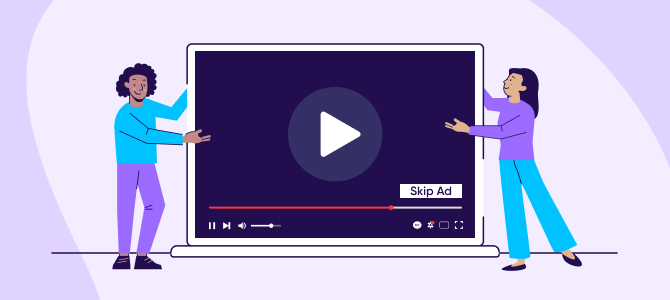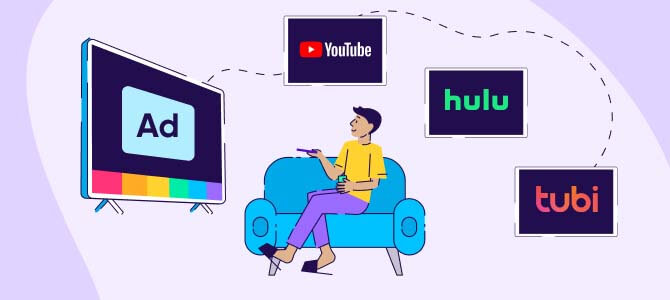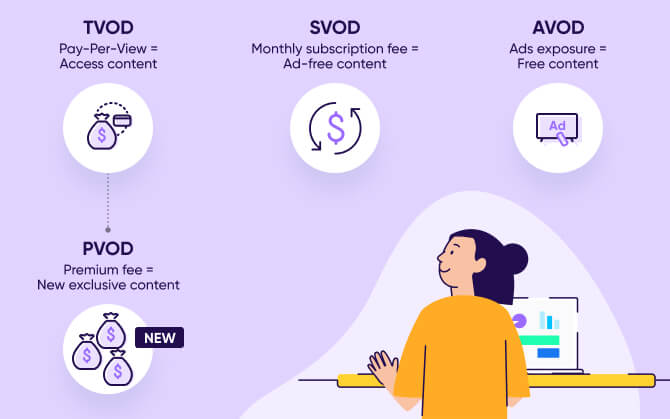What is AVOD?
AVOD stands for advertising-based video on demand. It’s a monetization model where video platforms offer free access to content and generate revenue through advertisements.
Try searching for
AVOD (advertising-based video on demand) is a monetization strategy used by video-on-demand platforms. It offers users free access to on-demand content, in exchange for watching ads. This generates ad revenue, which offsets production and hosting costs.

A monetization model used by several major video-on-demand platforms, AVOD offers viewers free, unlimited access to video content on the platform.
Instead of charging viewers to watch content, this strategy aims to tap into these platforms’ vast audiences to generate revenue from advertising.
Being able to watch their favorite videos for free is highly alluring for users, as evidenced by the hundreds of thousands of viewers who throng to these platforms. Figure this — the US is forecast to have around 140 million AVOD viewers by the end of 2023, growing to over 170 million by 2026.
Before we dive into the technicalities, let’s look at who’s who in the AVOD world and how the strategy makes money.
These are the OTT platforms that create or host content, where advertisers pay to place their ads.
The more attractive the content is for viewers, the more attractive it becomes for advertisers, and the more revenue it brings in for publishers.
Giving users free access to quality content adds up to a high view count on AVOD platforms.
Advertisers pay publishers to get their ads featured on streamed video content, helping them generate brand awareness and encourage conversion.
Advertisers usually rely on publishers for ad targeting on the platform. Publishers’ access to user-level data means they can deliver precise segmentation and highly personalized targeting, leading to better return on ad spend.
AVOD platforms don’t have to make or buy content: instead, it’s posted by an army of independent content creators. As well as building their own brands, these creators benefit from a share of the ad revenue and potential sponsorship opportunities.
The end consumers in the AVOD model, users are the viewers who access publishers’ platforms to watch their favorite content for free – while also watching the ads alongside it.

AVOD platforms are wildly popular with users, and nearly one in two internet users frequents them in the US.
The best-known AVOD platform is YouTube, the video behemoth with over 2.5 billion active users. Although signing up on the platform is free, accessing content means you have to watch ads before, during, or after your chosen videos.
YouTube shares its advertising revenue with its content creators, incentivizing them to keep making and posting videos.
Other popular AVOD platforms include Hulu and Tubi. Like YouTube, Hulu offers a premium plan for users who prefer to watch ad-free content.
So, how do AVOD platforms actually get the ads in front of viewers? There are two options:
This method inserts ads directly into the viewer’s video player (the client) in real time. Ad markers in the stream trigger an ad request, the video is paused, and a relevant ad is delivered to the user’s device before the video restarts. The real-time aspect gives advertisers full control and enables precise audience targeting.
With this option, ads are placed in the video stream on the server side, and then sent to the viewer’s device. It’s also known as dynamic ad insertion, because the ads can be tailored based on geography, behavior, demographics, and more.
Another name for this is ad stitching, because the ads are embedded (“stitched”) right into the content for a seamless viewing experience. An added benefit is that ads can then bypass ad blockers, as they appear as part of the content.
Users get free content, while advertisers, publishers, and creators make money — sounds like a win-win, right? It’s true that AVOD has a lot to offer, but it’s not without its challenges. Let’s look at the main pros and cons of this model.
84% of users claim they don’t mind watching ads in exchange for free content. That’s good news for advertisers and publishers: revenue in the AVOD market is projected to reach 41.13 billion US dollars in 2023, as more and more viewers choose to access their favorite content this way.
Unlike subscription-based services (Netflix or Disney+, for instance), AVOD platforms don’t have to invest in creating content or buying rights to it. Instead, they serve as a platform where content creators can upload their videos to reach their audience, and get a share of the revenue from advertising that’s incorporated in their content.
Offering content creators revenue incentives to upload their videos means that new content isn’t a challenge for AVOD platforms. The more people watch a piece of content, the more ad views it generates. That means more revenue for the platform, and a bigger slice of the pie for the content creator.
Advertisers have good reason to throng to AVOD platforms, as they provide access to a large and diverse user base, with personalized targeting based on publisher data.
Publishers can choose from different ad formats (more on this shortly), and decide at what point in the stream to display ads. This allows them to experiment to achieve the best user experience and ad impact.
When not done right, ads can disrupt the user experience, potentially leading to a drop in viewership and even churn. Some users may be willing to pay for a premium, ad-free plan, but the real secret here is to get the timing, creatives, and frequency right.
The passive nature of video viewing makes it hard for advertisers to measure the true impact of their ads. Unless a user actually clicks on your call to action (fairly unlikely if they’re in the middle of watching something), you won’t know if they’re even paying attention — they could be checking their phone or grabbing a snack while waiting for their video to play.
When advertisers are paying based on the number of ad views or clicks, the actual income the publisher receives can vary. If ads are skippable, viewers may not watch them, meaning no revenue is generated. Alternatively, as mentioned above, advertisers could be paying for “views” where the user wasn’t really watching. For publishers, adding a subscription option is a way to generate a more consistent income stream.

Now that we’ve established what AVOD is all about, let’s explore how it differs from other monetization models.
Short for subscription video on demand, these platforms require their users to pay regular, fixed subscription fees to access content. SVODs usually feature niche content and invest in content creation, winning them loyal users. Examples include Netflix, Amazon Prime Video, and Disney+.
Transactional video on demand platforms are similar to AVOD platforms in that users can sign up for free, but to access content on the platform, they’ll have to rent or buy it individually.
An example of a TVOD service would be Apple iTunes.
Short for premium video on demand, this model is typically used alongside other monetization models. It gives users first and exclusive access to brand-new content in exchange for a premium fee.
Disney+ used PVOD to great effect with “Mulan” in 2020: in some countries, the movie was running in theaters almost at the exact same time as being released (for a fee) on PVOD.

Free ad-supported television (FAST) works on the same principle as AVOD, in that users don’t have to pay to access content and the revenue source is advertisement — but that’s where the similarities end.
FAST channels are linear, like cable TV channels, delivering content to a vast audience with ad breaks. Unlike with AVOD, the user has no control over what’s being played on the channel. Popular FAST platforms include Pluto, Tubi, and Roku Channel.
We mentioned earlier that publishers can choose from a range of formats for displaying ads on AVOD. Here are the main types:
You might also come across the following:
Are you a publisher looking to monetize your OTT platform? AVOD could be the right model for you if:
If you’ve concluded that AVOD is the right model for you, follow these steps to get your platform up and running:
AVOD stands for advertising-based video on demand. It’s a monetization model where video platforms offer free access to content and generate revenue through advertisements.
The AVOD ecosystem benefits publishers by offering a platform for ad revenue, while users can enjoy free access to content. Advertisers benefit from access to a large audience with precise targeting, and content creators get revenue sharing and sponsorship opportunities.
AVOD’s advantages include high viewership, low risk for publishers, incentives for content creators, enhanced ad targeting, and ad format flexibility. However, it comes with challenges like potential poor user experience, difficulty of measuring ad impact, and uncertain revenue due to ads being skippable.
Unlike SVOD’s subscription fees, TVOD’s per-content charges, and PVOD’s premium early access fees, AVOD offers content for free with ad support. FAST channels share AVOD’s free, ad-supported approach but deliver linear, scheduled content without on-demand user control.
AVOD platforms use various ad formats, including pre-roll ads before videos, mid-roll ads during content, and post-roll ads after videos. Other options include display ads on the platform, banner ads alongside video playback, and interactive ads that engage viewers directly.